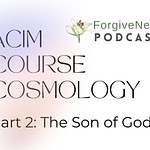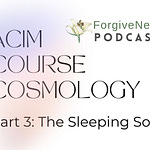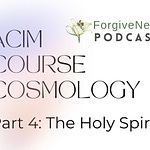ForgiveNest Podcast Transcript: Intro to ACIM ‘Course Cosmology’ Series - A Look at Resistance to Theism and Masculine Pronouns in A Course in Miracles, with Alison Anton
Hello and welcome to Course Cosmology. This is the intro video to our four-part series on the central characters of A Course in Miracles.
I'm Alison Anton with the ForgiveNest Podcast.
But before we get started, I just want to quickly mention that I'm using the term "cosmology" here lightly. Cosmology is technically the study of the known physical universe. And that might lead you to ask, so what do the characters of A Course in Miracles have to do with cosmology?
The short answer is because the characters of the Course are the cosmos from the ACIM perspective. We're focusing our cosmological study on the Cosmos of God, or what the Course calls "reality" or the Kingdom of God or the Kingdom of Heaven.
And we'll take a very bite sized peak at the visible universe as well. But by and large, our discussion in the next four videos revolves around the Holy Trinity that makes up the Cosmos of God, namely: God, the Son of God, the sleeping Son of God, and the Holy Spirit.
So there are four characters here. Is this still the Holy Trinity that we're talking about?
Yes. Three characters, but four talking points. We'll talk in part three about how the sleeping Son of God is really still the Son of God blocking awareness of his true identity.
Regarding Jesus as a Son of God
And on the subject of the Son of God, something to note is that I'm not specifically including Jesus in that part of our discussion in Course Cosmology. If you're a Course student, you already know that for one, Jesus is the claimed author of the Course. And he does include himself as one of the Sons of God, but he also includes us. And together we, along with him, make up the entire Sonship. We'll talk about the Son of God in part two, but we'll highlight the entirety of the Sonship rather than specifically highlighting Jesus.
Jesus as the Author of ACIM
A few words here on that Jesus is the purported author of the Course. I'd like to include a short segment from Inside the Front Matter of the Complete and Annotated Edition of A Course in Miracles, published by The Circle of Atonement. And I want to read it because it perfectly captures what I would try to say about Jesus's authorship of the Course, and I'd rather just pass this on from the CE than trying to rewrite the same thing in my own words.
So here's what they say:
"Although the identity of the voice that authored the Course cannot be proven, we do have to call him, or it, something. Throughout the Complete and Annotated Edition, we will call him by the name Jesus, not as an statement of established fact, not as something you are required to believe, but merely because this is the name the author gives himself, and because we ourselves accept that claim." [ACIM CE Front-2.27]
And I personally will add myself to that last line as accepting that claim.
The Complete and Annotated Edition of A Course in Miracles
And one more side note here while we're on the topic of the Complete and Annotated Edition of A Course in Miracles, it's the version I'm using for all references in this series, and it's the edition I currently study.
It's more than fine if you're using the traditional Blue Book. I studied the Blue Book for 25 years before moving to the Complete Edition (CE) in 2024. The concepts are the same in both versions. I'll talk more about the CE in another episode, but for now, if you want to download their free web or phone app, you can do that at CircleofA.org.
On Theism and Masculine Pronouns in the Course
So let's talk a bit on Course grammar and it's theistic terminology, and also its traditional grammatical use of masculine subjects and subject pronouns. I'm mentioning these in this intro video because some people have resistance to these, understandably, which can be a deterrent though, to stepping fully into the Course if the resistance is strong.
If you generally like to view creation as non-theistic versus involving a prime creator, or, if the overuse on this planet of masculine pronouns associated with a prime creator is frustrating to you, these aspects of the Course might feel controversial. So if that's you, I'm hoping to help to get you through some of that resistance if you're called to the Course, but are bumping into it.
Masculine Subjects and Pronouns
So let's speak to the masculine subjects and pronouns first.
In the Course, the masculine association with the Holy Trinity is simply a grammatical one that falls in line with traditional Christian terminology—and I emphasize “grammatical” here because that's pretty much where the similarity stops between the traditional Christian caricature of the Holy Trinity and the ACIM caricature of the Holy Trinity.
Nowhere in the Course does it suggest that any member of the Holy Trinity is actually male or masculine in either form or energy. So the level of God's Kingdom that Jesus talks about in the Course goes far beyond gender association, even the very subtlest of levels.
The Course does refer to God as the "Father", and of course, the Son as the Son, but it never alludes to that either of these have an actual male quality or even an energetic essence of the masculine. Even on the ultimate level of pure creation, there are no references to that God's ability to create requires masculine or even feminine energy, for that matter to make creation happen.
And also to note on that level, the Son of God, from the Course perspective, is not on the level of form or humanity either. So gender association just doesn't fit there either.
From this perspective, we really have to remind ourselves that the only way the Course associates these characters with the masculine is grammatically. It's simply following the symbolic language of most theologic traditions.
So then you might think, well, is there a way to add some femininity to the Course to make it feel more balanced? It's an interesting question, and I think people try to do it a lot, but if we answer honestly, the answer is, well, sure we could, but ultimately we come to the conclusion that the curriculum isn't actually imbalanced. The message to the reader isn't skewed toward the masculine; only in a grammatical sense. The curriculum itself is all inclusive.
Theism in the Course
Let's quickly look at theism.
For some people, the resistance isn't in the male-female aspect at all, but more in general about the Course taking a theistic view, or a God-centered view.
That piece isn't grammatical. The words are symbolic, yeah, but the Course clearly states there is a distinct Creator who created us and all of Heaven. The Course's purpose is to help us find our way back to God. So it's not gonna be easy to sweep that one under the carpet, at least for long.
Of course, you don't have to believe in God to study A Course in Miracles, but you do have to have an open mind to think about the concepts. We all, of course, have these resistances. But until we really know—based on our experience and not what someone says about it—there's always going to be that question mark hanging over whether there's a creator or not, or a realm like Heaven or Nirvana beyond the physical, and even beyond the higher dimensions.
There's a couple of passages I'd like to read that might help with any resistance that you're having to Course terminology, theology, or symbology. This is the epilogue to the Clarification of Terms at the back of the book. I'll talk about this section and the Glossary in a minute, but let's look at a few key sentences here first. Here's what it says:
"A universal theology is impossible, but a universal experience is not only possible but necessary. It is this experience toward which the course is aimed. Here alone, consistency becomes possible, because here alone, uncertainty ends." [ACIM CE C-In.2]
He's saying here that it's impossible to find consistency in any kind of symbol, be it theology as a symbol or a word on a page as a symbol. None of these are universal. Only through a universal experience is consistency found, and that's what the Course is aimed toward.
Then he goes on to say:
"This course remains within the ego framework where it is needed… Therefore, it uses words which are symbolic and cannot express what lies beyond symbols." [ACIM CE C-In.2-3]
At some point, whatever path we choose, we have to read beyond the symbols on the page so that we can get to the experience that the path is leading us to. This goes with any spiritual path.
Of course, we all know that some religious and spiritual paths use symbols and language for fear, control, and power. So we're always, rightfully so, on the lookout for that, and we need to make sure the curriculum is peaceful. That requires some time to study it, and at least for the time being to diminish some of the resistances so that we can look beyond words and symbols to see if that curriculum really, truly is peaceful and the one for us.
And keep that in mind as you go through this four part series. Jesus said in the passage earlier that it's a universal experience in which the Course is aimed not a universal symbology.
The Glossary and Clarification of Terms in ACIM
Before we end, I said earlier I would enlighten you to a couple sections in the Course—in both the Blue Book and the CE—that don't seem to be part of the Course per se, but are such valuable learning aids, whether you're a new student or an old student. These are the Glossary and the Clarification of Terms at the back of the book.
I think seasoned students should be referring to these again and again while going through the text and the workbook. It's like a checks and balances of our understanding, but I also think it's an essential prerequisite for new students before diving into the Course as well.
All of the characters we'll be discussing in this four part series are covered in the Glossary and the Clarification of Terms, as well as many of the concepts, like, the Kingdom of God, the ego, and the separation, forgiveness, and extension versus projection. You can do some preliminary reading now or while you're progressing through the video series.
Up Next in ACIM Course Cosmology: Part 1, God Our Creator
Next up is part 1 of ‘Course Cosmology’ on God, Our Creator, from the perspective of A Course in Miracles.
Thanks for joining me in this intro session.
I'm Alison Anton with the ForgiveNest Podcast.
It was great talking to you.






